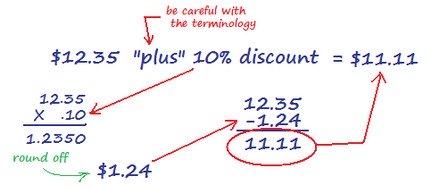Business Math to study
for the Pharmacy Tech Exam
By Ron Aylor, CPhT
Business calculations involving markup, discount, net/gross profit, and inventory control are routinely encountered in the pharmacy. Pharmacy Technicians should have a basic knowledge and understanding of these numerical concepts and simple equations.
Markup
Markup is simply the difference between what we sell a medication for and what it costs us. In other words, it's our "profit"
If a medication costs us $20 and we sell it for $30, the markup is $10.
Markup Percentage
Some people think in terms of dollars, while others think in terms of percentages. Markup can be expressed as a dollar figure (gross profit), or it can be a percentage (percent markup). Calculating gross profit is really quite simple. All that is required is to take the selling price (what a medication actually sells for) and subtract the cost. If we are selling a medication for $30 that cost us $20, our gross profit is $10. To calculate percent markup, divide the gross profit by the cost. From our example: $10 divided $20 = 0.5; converting this number to a percent, we can say we have a 50% markup.
Net Profit
To this point the $20 cost of medication has been just that - the cost of the medication. We have not taken into consideration the time to process the prescription, the cost of the container, the cost of the label, the cost of the bag, the various salaries of the personnel, the utility bills, rent, and other such costs associated with operating a pharmacy.All of these various costs are calculated and a percentage is presented as what is called a professional or dispensing fee.
This fee is then added to the cost of a medication, thus capturing all of the costs associated with filling a prescription. When this fee is added to the cost of medication, ALL of the calculations performed for gross profit become NET profit. Its really that simple! Gross profit is the difference between what we sell a medication for and what THAT medication cost. Net profit is the difference between what we sell a medication for and what it cost us to fill the prescription, medication and ALL.
Discount
Discounts are really quite simple, the final selling price is reduced by a pre-determined amount. That's all there is to it! Let's say that our selling price for a particular prescription is $12.35 and the patient qualifies for a 10% discount; multiply $12.35 by 10% to get $1.24; now subtract $1.24 from $12.35 and the patient pays $11.11 for the prescription.
Third party contractual agreements and some State
pharmacy regulations may prohibit discounting prescriptions covered by
third party programs. Usually, discounting is limited to patients paying
cash.
Examples and Video:
- Here is an Example Business Math Question that deals with discounts.
- Here is an Example Sales Tax Math Question that also deals with discounts.
Where would you like to go now?



